Synergistic Regulation of Vegetation Greening and Climate Change on the Changes in Evapotranspiration and Its Components in the Karst Area of China
Abstract
1. Introduction
2. Materials and Methods
2.1. Overview of the Study Area
2.2. Data Sources and Processing
2.2.1. Remote Sensing Data
2.2.2. ET Data
2.2.3. Climate Data
2.2.4. Land Cover Data
2.3. Research Methodology
2.3.1. PT-JPL Model Framework for ET Estimation
2.3.2. Validation Metrics for the PT-JPL Model Results
2.3.3. Scenario Design
2.3.4. Trend Analysis
2.3.5. Partial Correlation Analysis
2.3.6. Multiple Regression Analysis of ET
2.3.7. Path Analysis
3. Results
3.1. PT-JPL Model Validation Against GLEAM ET
3.2. Spatiotemporal Patterns of Climatic Factors
3.3. Climatic Controls on ET and Its Components
3.4. Impacts of Vegetation Change on ET and Its Components
3.5. Path Analysis of Direct and Indirect Effects
4. Discussion
4.1. Spatiotemporal Variations in Simulated ET and Its Components
4.2. Climatic Controls on ET in Southwest China’s Karst Region
4.3. Implications and Recommendations for Regional Water and Vegetation Management
5. Conclusions
Supplementary Materials
Author Contributions
Funding
Data Availability Statement
Acknowledgments
Conflicts of Interest
References
- Bhattarai, N.; Wagle, P. Recent Advances in Remote Sensing of Evapotranspiration. Remote Sens. 2021, 13, 4260. [Google Scholar] [CrossRef]
- Ma, N.; Zhang, Y.; Szilagyi, J. Water-balance-based evapotranspiration for 56 large river basins: A benchmarking dataset for global terrestrial evapotranspiration modeling. J. Hydrol. 2024, 630, 130607. [Google Scholar] [CrossRef]
- Ebrahimian, A.; Wadzuk, B.; Traver, R. Evapotranspiration in green stormwater infrastructure systems. Sci. Total Environ. 2019, 688, 797–810. [Google Scholar] [CrossRef]
- Huo, W.; Zhi, X.; Hu, S.; Cai, W.; Yang, F.; Zhou, C.; Mamtimin, A.; He, Q.; Pan, H.; Song, M.; et al. Refined assessment of potential evapotranspiration in the Tarim basin. Front. Earth Sci. 2022, 10, 904129. [Google Scholar] [CrossRef]
- Jin, L.; Chen, S.; Yang, H.; Zhang, C. Evaluation and Drivers of Four Evapotranspiration Products in the Yellow River Basin. Remote Sens. 2024, 16, 1829. [Google Scholar] [CrossRef]
- Jiao, Y.; Zhu, G.; Qiu, D.; Liu, Y.; Wang, L.; Lu, S.; Meng, G.; Lin, X.; Li, R.; Wang, Q.; et al. Hydrological effects of evapotranspiration in the Qilian Mountains forest belt. Hydrol. Earth Syst. Sci. Discuss. 2023, 2023, 1–24. [Google Scholar] [CrossRef]
- Liu, M.; Xu, X.; Wang, D.; Sun, A.Y.; Wang, K. Karst catchments exhibited higher degradation stress from climate change than the non-karst catchments in southwest China: An ecohydrological perspective. J. Hydrol. 2016, 535, 173–180. [Google Scholar] [CrossRef]
- Liang, P.; Wang, X.; Xu, Q.; Zhang, J.; Fang, R.; Fu, Z.; Chen, H. Lithology-mediated soil erodibility characteristics after vegetation restoration in the karst region of Southwest China. Land Degrad. Dev. 2024, 35, 1074–1086. [Google Scholar] [CrossRef]
- Guan, N.; Cheng, J.; Shi, X. Preferential Flow and Preferential Path Characteristics of the Typical Forests in the Karst Region of Southwest China. Forests 2023, 14, 1248. [Google Scholar] [CrossRef]
- Tan, K.; Zhao, X.; Pu, J.; Li, S.; Wang, Q. Zoning regulation and development model for water and land resources in the Karst Mountainous Region of Southwest China. Land Use Policy 2021, 109, 105683. [Google Scholar] [CrossRef]
- Huang, B.; Lu, F.; Sun, B.; Wang, X.; Li, X.; Ouyang, Z.; Yuan, Y. Climate Change and Rising CO2 Amplify the Impact of Land Use/Cover Change on Carbon Budget Differentially Across China. Earth’s Future 2023, 11, e2022EF003057. [Google Scholar] [CrossRef]
- Zhang, J.; Chen, H.; Fu, Z.; Wang, K. Effects of vegetation restoration on soil properties along an elevation gradient in the karst region of southwest China. Agric. Ecosyst. Environ. 2021, 320, 107572. [Google Scholar] [CrossRef]
- Liu, M.; Xu, X.; Sun, A.Y.; Wang, K.; Liu, W.; Zhang, X. Is Southwestern China experiencing more frequent precipitation extremes? Environ. Res. Lett. 2014, 9, 479–489. [Google Scholar] [CrossRef]
- Kang, Y.; Shen, L.; Li, C.; Huang, Y.; Chen, L. Effects of vegetation degradation on soil microbial communities and ecosystem multifunctionality in a Karst region, Southwest China. J. Environ. Manag. 2024, 363, 121395. [Google Scholar] [CrossRef]
- Cao, Y.; Xiong, K. Soil Quality Assessment Under Different Vegetation Restoration Strategies in the Karst Rocky Deserted Area of Southwestern China. J. Soil Sci. Plant Nutr. 2024, 24, 3249–3264. [Google Scholar] [CrossRef]
- Talsma, C.J.; Good, S.P.; Jimenez, C.; Martens, B.; Fisher, J.B.; Miralles, D.G.; Mccabe, M.F.; Purdy, A.J. Partitioning of evapotranspiration in remote sensing-based models. Agric. For. Meteorol. 2018, 260–261, 131–143. [Google Scholar] [CrossRef]
- Yu Qiu, G.; Momii, K.; Yano, T.; Lascano, R.J. Experimental verification of a mechanistic model to partition evapotranspiration into soil water and plant evaporation. Agric. For. Meteorol. 1999, 93, 79–93. [Google Scholar] [CrossRef]
- Zhang, B.; Tian, L.; Zhao, X.; Wu, P. Feedbacks between vegetation restoration and local precipitation over the Loess Plateau in China. Sci. China Earth Sci. 2021, 64, 920–931. [Google Scholar] [CrossRef]
- Khanmohammadi, N.; Rezaie, H.; Montaseri, M.; Behmanesh, J. The application of multiple linear regression method in reference evapotranspiration trend calculation. Stoch. Environ. Res. Risk Assess. 2018, 32, 661–673. [Google Scholar] [CrossRef]
- Wang, C.; Liang, W.; Yan, J.; Jin, Z.; Zhang, W.; Li, X. Effects of vegetation restoration on local microclimate on the Loess Plateau. J. Geogr. Sci. 2022, 32, 291–316. [Google Scholar] [CrossRef]
- Williams, I.N.; Torn, M.S. Vegetation controls on surface heat flux partitioning, and land-atmosphere coupling. Geophys. Res. Lett. 2015, 42, 9416–9424. [Google Scholar] [CrossRef]
- Han, P.; Yang, G.; Liu, Y.; Chen, X.; Wen, Z.; Shi, H.; Hu, E.; Xue, T.; Zhao, Y. Vegetation Restoration Enhanced Canopy Interception and Soil Evaporation but Constrained Transpiration in Hekou–Longmen Section During 2000–2018. Agronomy 2024, 14, 2606. [Google Scholar] [CrossRef]
- Wang, K.; Han, L.; Liao, J. Threshold analysis of the key factors of rocky desertification evolution in the typical karst region of China. All Earth 2025, 37, 1–14. [Google Scholar] [CrossRef]
- Hsiao, J.; Swann, A.L.S.; Kim, S. Maize yield under a changing climate: The hidden role of vapor pressure deficit. Agric. For. Meteorol. 2019, 279, 107692. [Google Scholar] [CrossRef]
- Febles Díaz, J.M.; Febles González, J.M.; González Calvo, T.; Tolón Becerra, A.; Sotelo Pérez, M.; Lastra-Bravo, X. Dual effects of carbon in Red Ferralitic soils in the San José de Las Lajas Polje, Cuba. Geoderma 2022, 407, 115525. [Google Scholar] [CrossRef]
- Zhao, M.; Geruo, A.; Liu, Y.; Konings, A.G. Evapotranspiration frequently increases during droughts. Nat. Clim. Change 2022, 12, 1024–1030. [Google Scholar] [CrossRef]
- Oliveira, S.; Cunha, J.; Nóbrega, R.L.B.; Gash, J.H.; Valente, F. Enhancing global rainfall interception loss estimation through vegetation structure modeling. J. Hydrol. 2024, 631, 130672. [Google Scholar] [CrossRef]
- Yang, Y.; Roderick, M.L.; Guo, H.; Miralles, D.G.; Zhang, L.; Fatichi, S.; Luo, X.; Zhang, Y.; Mcvicar, T.R.; Tu, Z.; et al. Evapotranspiration on a greening Earth. Nat. Rev. Earth Environ. 2023, 4, 626–641. [Google Scholar] [CrossRef]
- Sinacore, K.; Asbjornsen, H.; Hernandez-Santana, V.; Hall, J.S. Drought Differentially Affects Growth, Transpiration, and Water Use Efficiency of Mixed and Monospecific Planted Forests. Forests 2019, 10, 153. [Google Scholar] [CrossRef]
- Ohta, T.; Maximov, T.C.; Dolman, A.J.; Nakai, T.; van der Molen, M.K.; Kononov, A.V.; Maximov, A.P.; Hiyama, T.; Iijima, Y.; Moors, E.J.; et al. Interannual variation of water balance and summer evapotranspiration in an eastern Siberian larch forest over a 7-year period (1998–2006). Agric. For. Meteorol. 2008, 148, 1941–1953. [Google Scholar] [CrossRef]
- Zhang, J.; Zhang, P.; Liu, Y.; Lu, S.; Wu, G. An analysis of the spatiotemporal evolution and driving force of cultivated land green utilization in Karst region of southwest China. J. Clean. Prod. 2024, 434, 140002. [Google Scholar] [CrossRef]
- Liu, Y.; Shan, F.; Yue, H.; Wang, X. Characteristics of drought propagation and effects of water resources on vegetation in the Karst area of Southwest China. Sci. Total Environ. 2023, 891, 164663. [Google Scholar] [CrossRef]
- Han, X.; Zhang, B.; Liu, T.; Wang, J.; Zhou, Q.; Che, Z. The effect of time scales on the distribution of evapotranspiration and driving factors in desert grasslands. Agric. Water Manag. 2023, 284, 108348. [Google Scholar] [CrossRef]
- Kong, Z.; Wang, T.; Han, Q.; Dai, Y.; Zuo, Y.; Wang, L.; Lang, Y. Impacts of environmental factors on ecosystem water use efficiency: An insight from gross primary production and evapotranspiration dynamics. Agric. For. Meteorol. 2025, 362, 110382. [Google Scholar] [CrossRef]
- Xiao, M.; Yu, Z.; Kong, D.; Gu, X.; Mammarella, I.; Montagnani, L.; Arain, M.A.; Merbold, L.; Magliulo, V.; Lohila, A.; et al. Stomatal response to decreased relative humidity constrains the acceleration of terrestrial evapotranspiration. Environ. Res. Lett. 2020, 15, 94066. [Google Scholar] [CrossRef]
- Li, X.; Zhao, L.; Wang, N.; Liu, H.; Xie, C.; Zhang, Z.; Dong, X. Evapotranspiration partitioning and its influencing factors in an alpine meadow ecosystem: Using laser-based isotope monitoring techniques. Catena 2025, 252, 108834. [Google Scholar] [CrossRef]
- Gillner, S.; Vogt, J.; Tharang, A.; Dettmann, S.; Roloff, A. Role of street trees in mitigating effects of heat and drought at highly sealed urban sites. Landsc. Urban Plan. 2015, 143, 33–42. [Google Scholar] [CrossRef]
- Cheng, L.; Yang, M.; Wang, X.; Wan, G. Spatial and Temporal Variations of Terrestrial Evapotranspiration in the Upper Taohe River Basin from 2001 to 2018 Based on MOD16 ET Data. Adv. Meteorol. 2020, 2020, 3721414. [Google Scholar] [CrossRef]
- Rashid, M.A.; Andersen, M.N.; Wollenweber, B.; Kørup, K.; Zhang, X.; Olesen, J.E. Impact of heat-wave at high and low VPD on photosynthetic components of wheat and their recovery. Environ. Exp. Bot. 2018, 147, 138–146. [Google Scholar] [CrossRef]
- Zhu, Z.; Zheng, Y.; Kong, H.; Xiong, J.; Zheng, H. Towards real-weather water-production practice for solar-driven reverse distillation: Effects of ambient temperature and solar radiation. Desalination 2025, 608, 118826. [Google Scholar] [CrossRef]
- Cai, X. Water stress, water transfer and social equity in Northern China—Implications for policy reforms. J. Environ. Manag. 2008, 87, 14–25. [Google Scholar] [CrossRef]
- Chen, J.; Luo, W.; Zeng, G.; Wang, Y.; Lyu, Y.; Cai, X.; Zhang, L.; Cheng, A.; Zhang, X.; Wang, S. Response of surface evaporation and subsurface leakage to precipitation for simulated epikarst with different rock–soil structures. J. Hydrol. 2022, 610, 127850. [Google Scholar] [CrossRef]
- Li, X.; Guo, M.; Wang, H. Impact of soil texture and salt type on salt precipitation and evaporation under different hydraulic conditions. Hydrol. Process. 2022, 36, e14763. [Google Scholar] [CrossRef]
- Feng, K.; Siu, Y.L.; Guan, D.; Hubacek, K. Assessing regional virtual water flows and water footprints in the Yellow River Basin, China: A consumption based approach. Appl. Geogr. 2012, 32, 691–701. [Google Scholar] [CrossRef]
- Villarreal, S.; Vargas, R.; Yepez, E.A.; Acosta, J.S.; Castro, A.; Escoto-Rodriguez, M.; Lopez, E.; Martínez-Osuna, J.; Rodriguez, J.C.; Smith, S.V.; et al. Contrasting precipitation seasonality influences evapotranspiration dynamics in water-limited shrublands. J. Geophys. Res. Biogeosci. 2016, 121, 494–508. [Google Scholar] [CrossRef]
- Wang, Z.; Cui, Z.; He, T.; Tang, Q.; Xiao, P.; Zhang, P.; Wang, L. Attributing the Evapotranspiration Trend in the Upper and Middle Reaches of Yellow River Basin Using Global Evapotranspiration Products. Remote Sens. 2022, 14, 175. [Google Scholar] [CrossRef]
- Adinehvand, R.; Raeisi, E.; Hartmann, A. A step-wise semi-distributed simulation approach to characterize a karst aquifer and to support dam construction in a data-scarce environment. J. Hydrol. 2017, 554, 470–481. [Google Scholar] [CrossRef]
- Shang, S.; Zhu, G.; Zhang, K.; Chen, H.; Wang, Y.; Chen, Y.; Zhang, Z.; Ma, N. Spatial-temporal variations in evapotranspiration across the continental United States: An atmospheric water balance perspective. J. Hydrol. 2024, 640, 131699. [Google Scholar] [CrossRef]
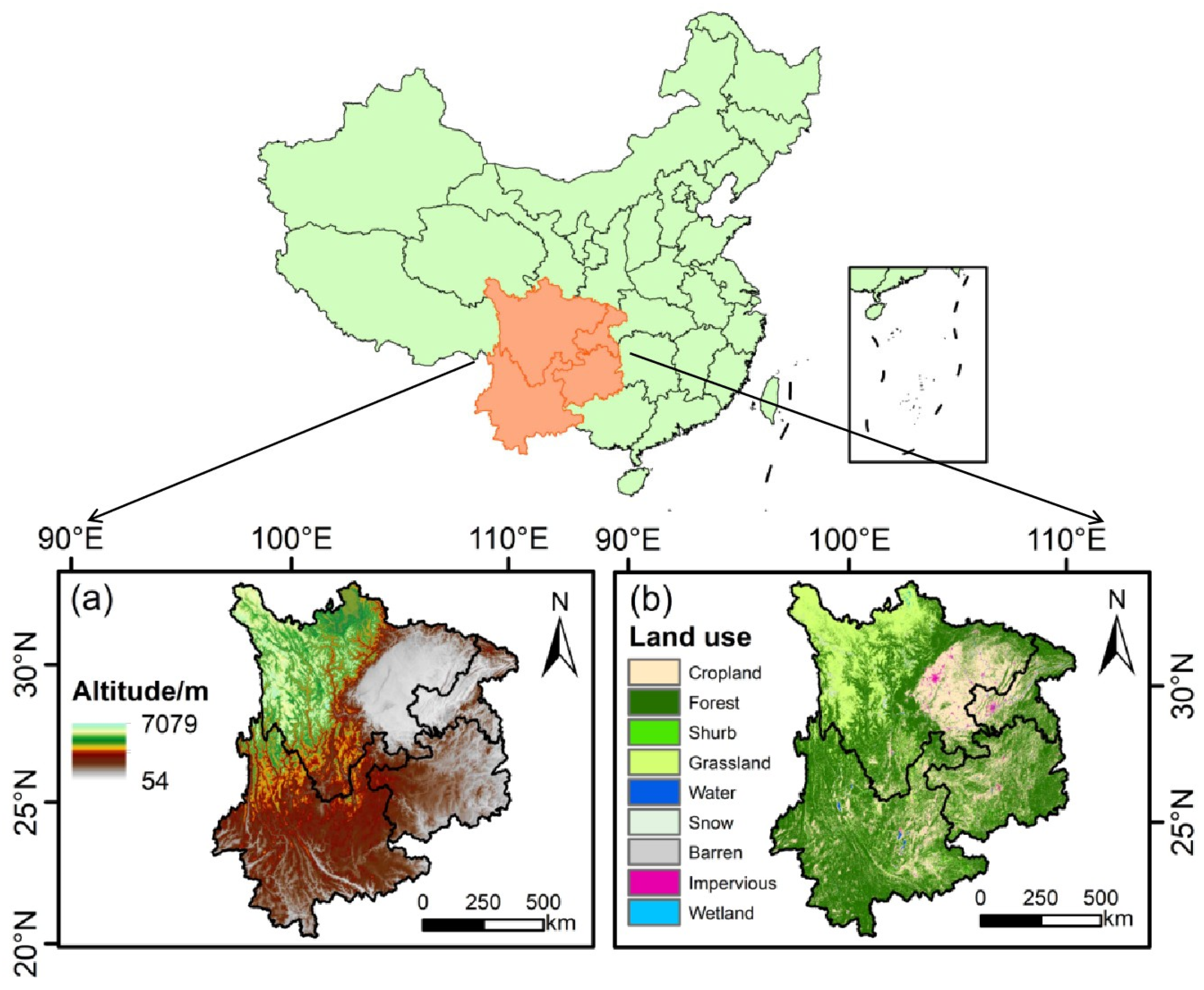
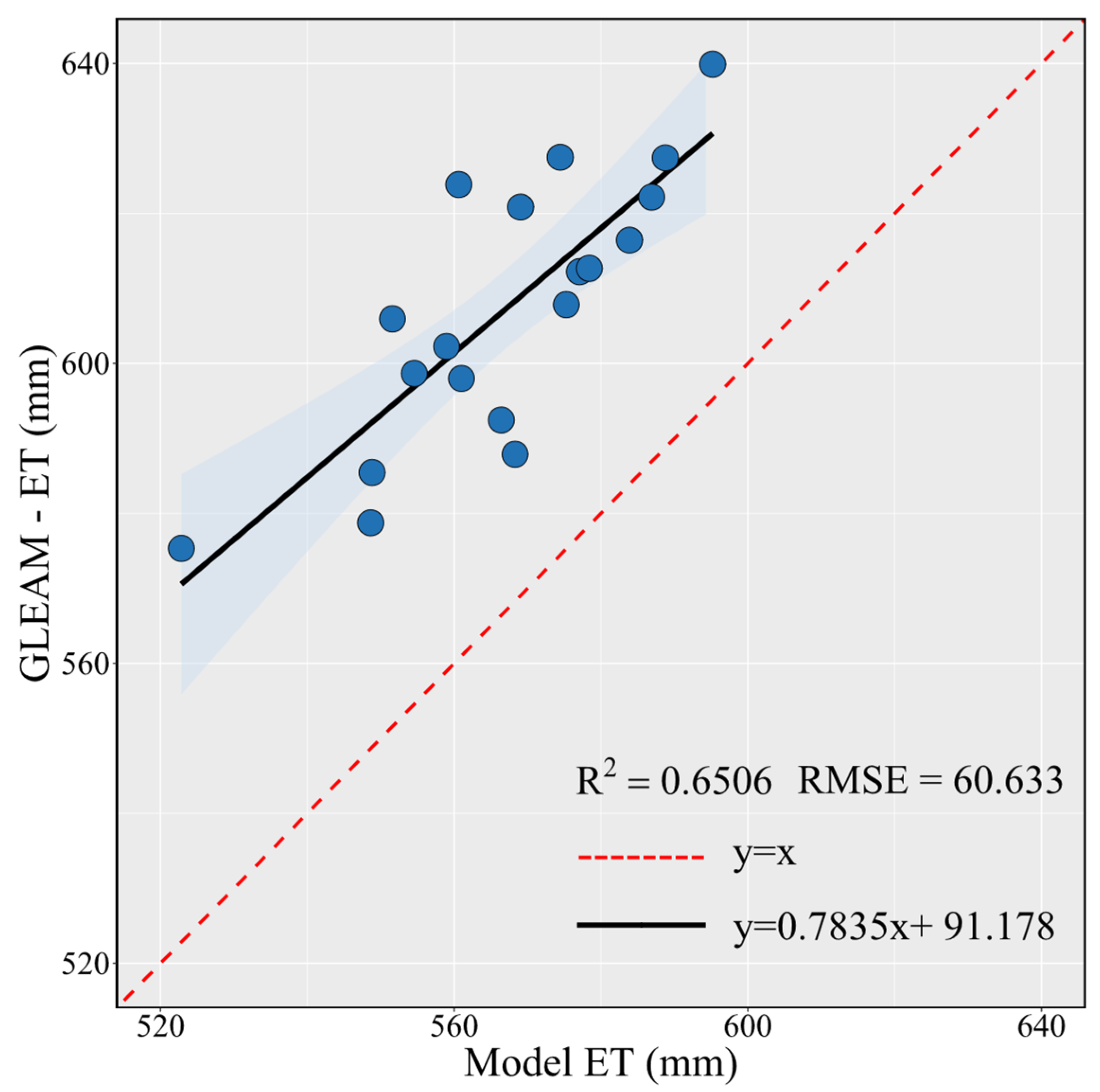
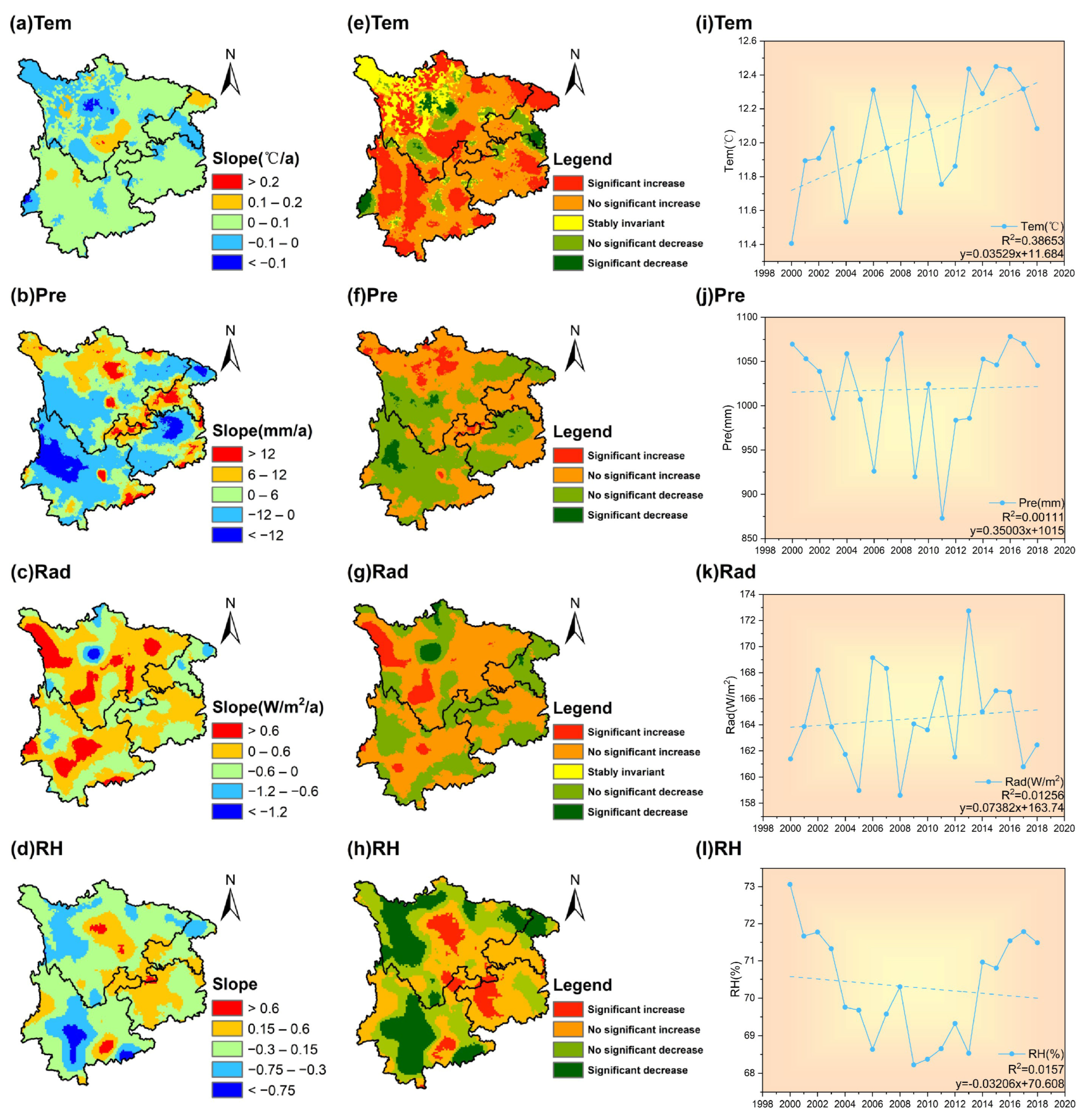

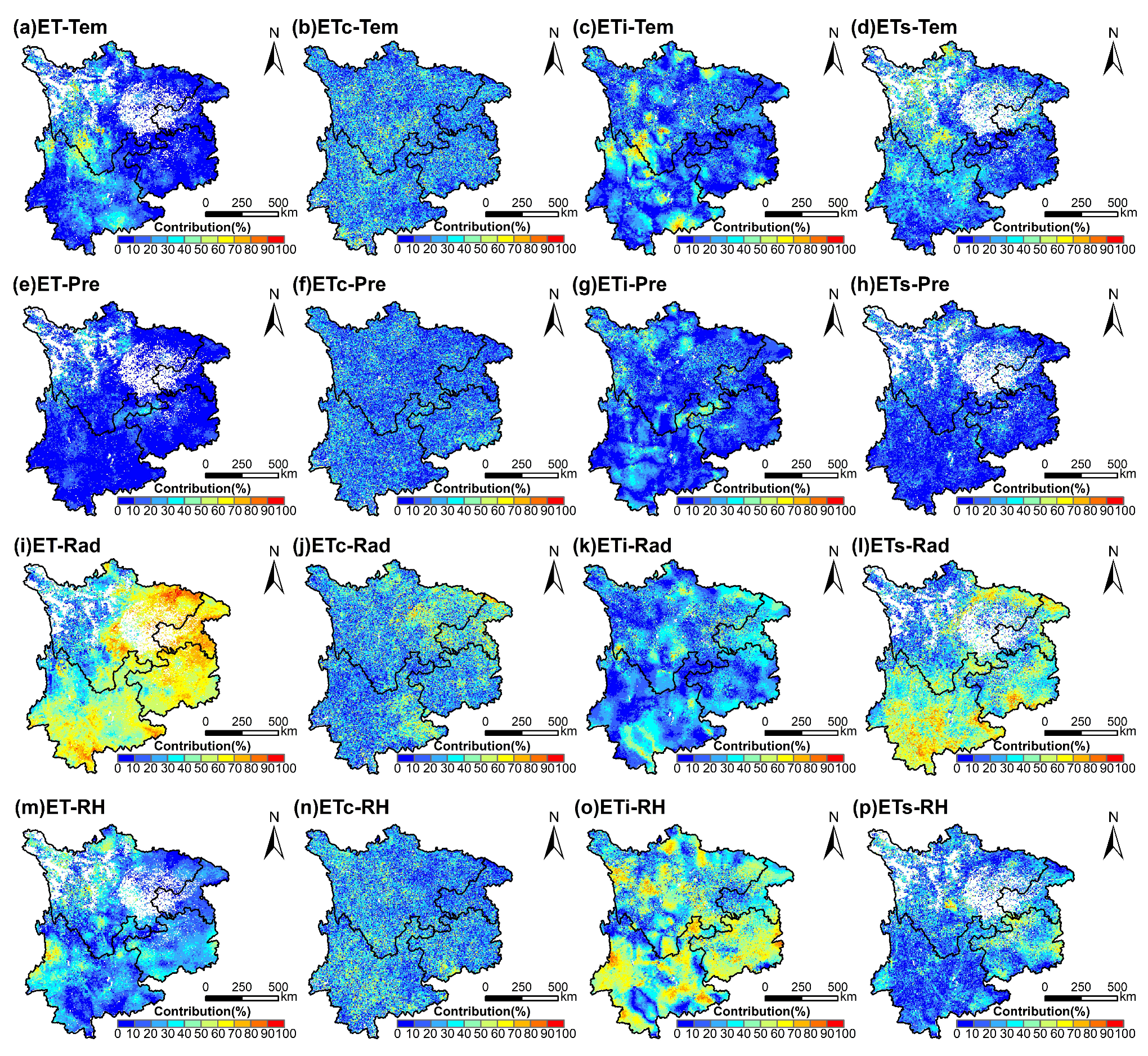
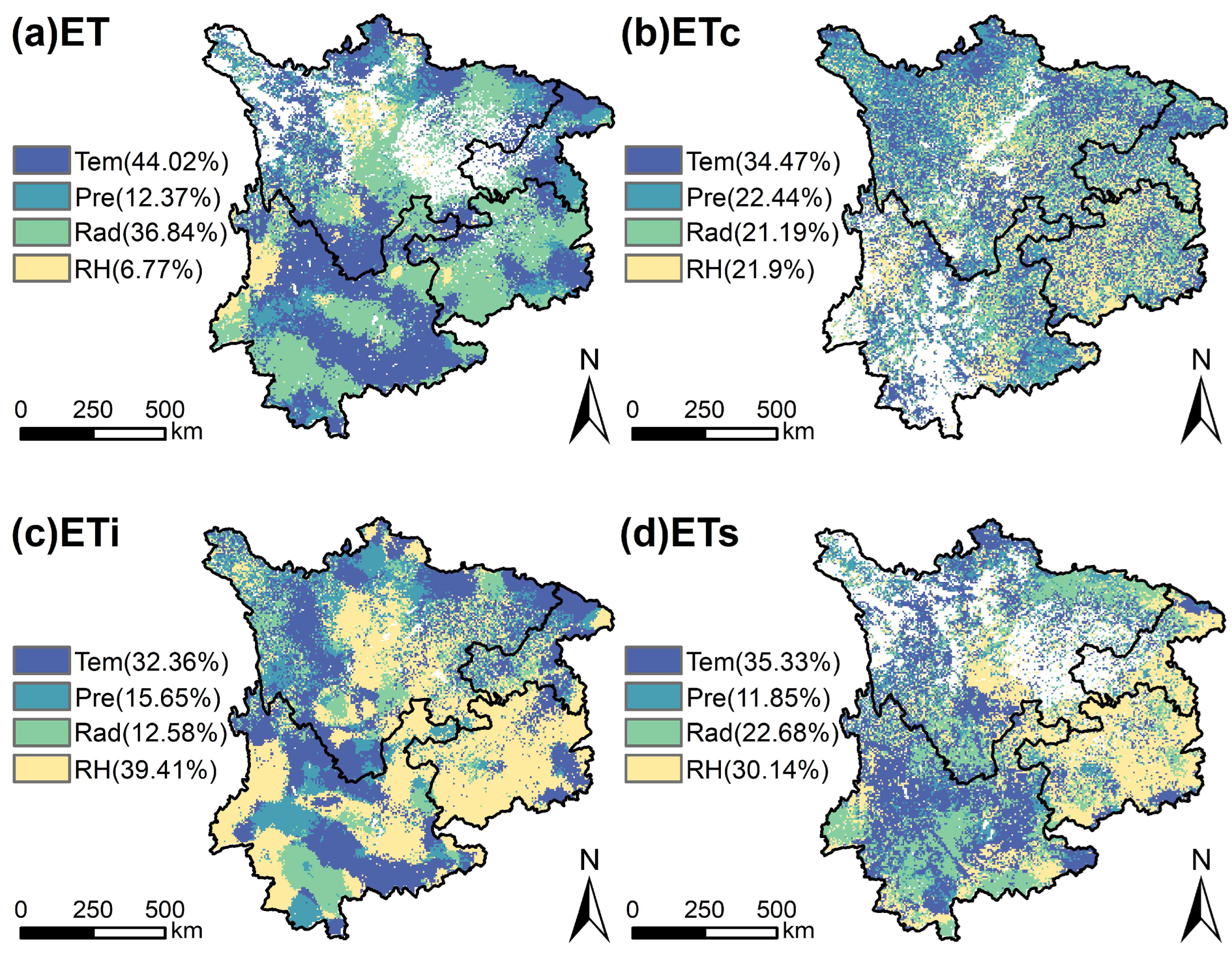
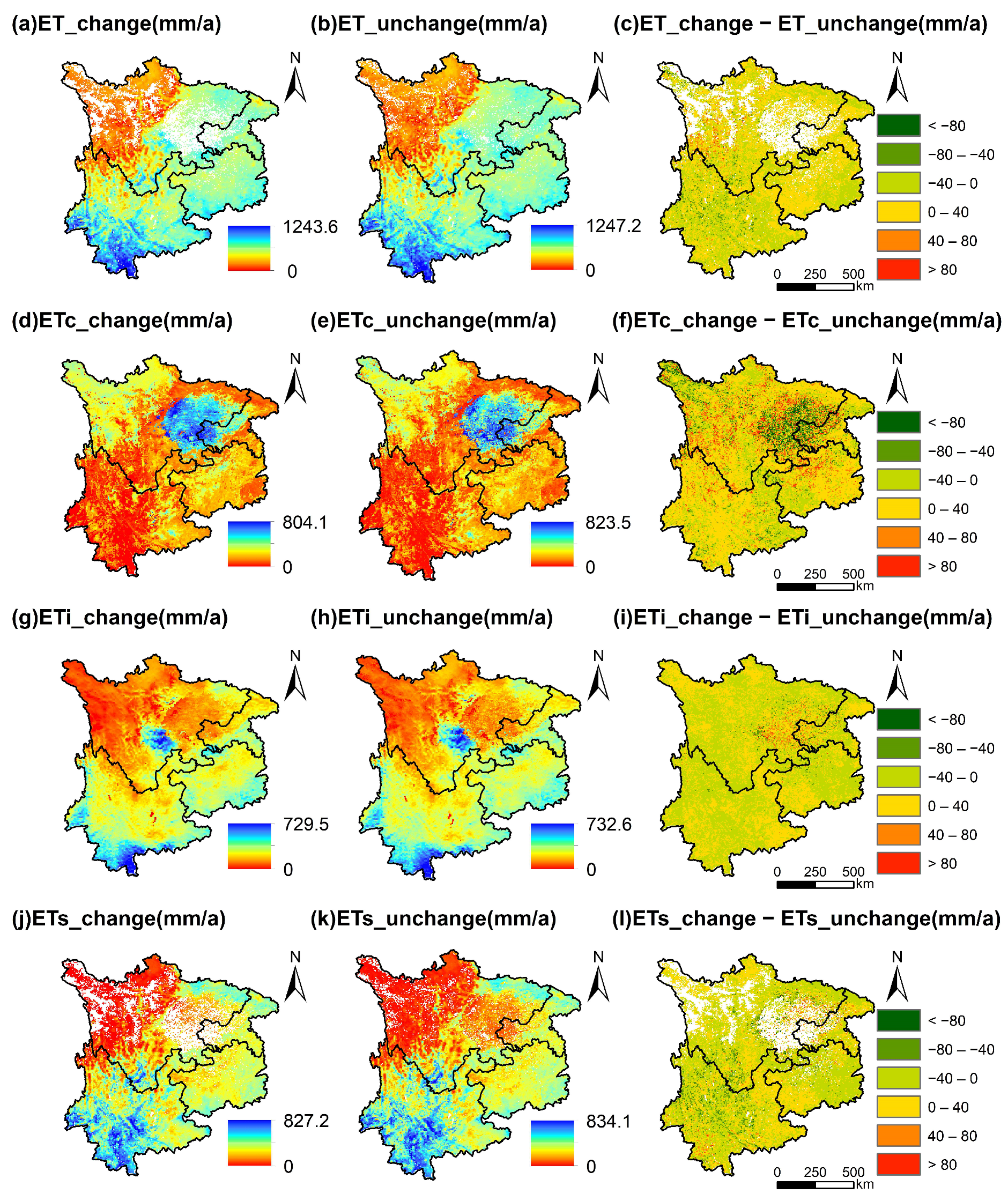
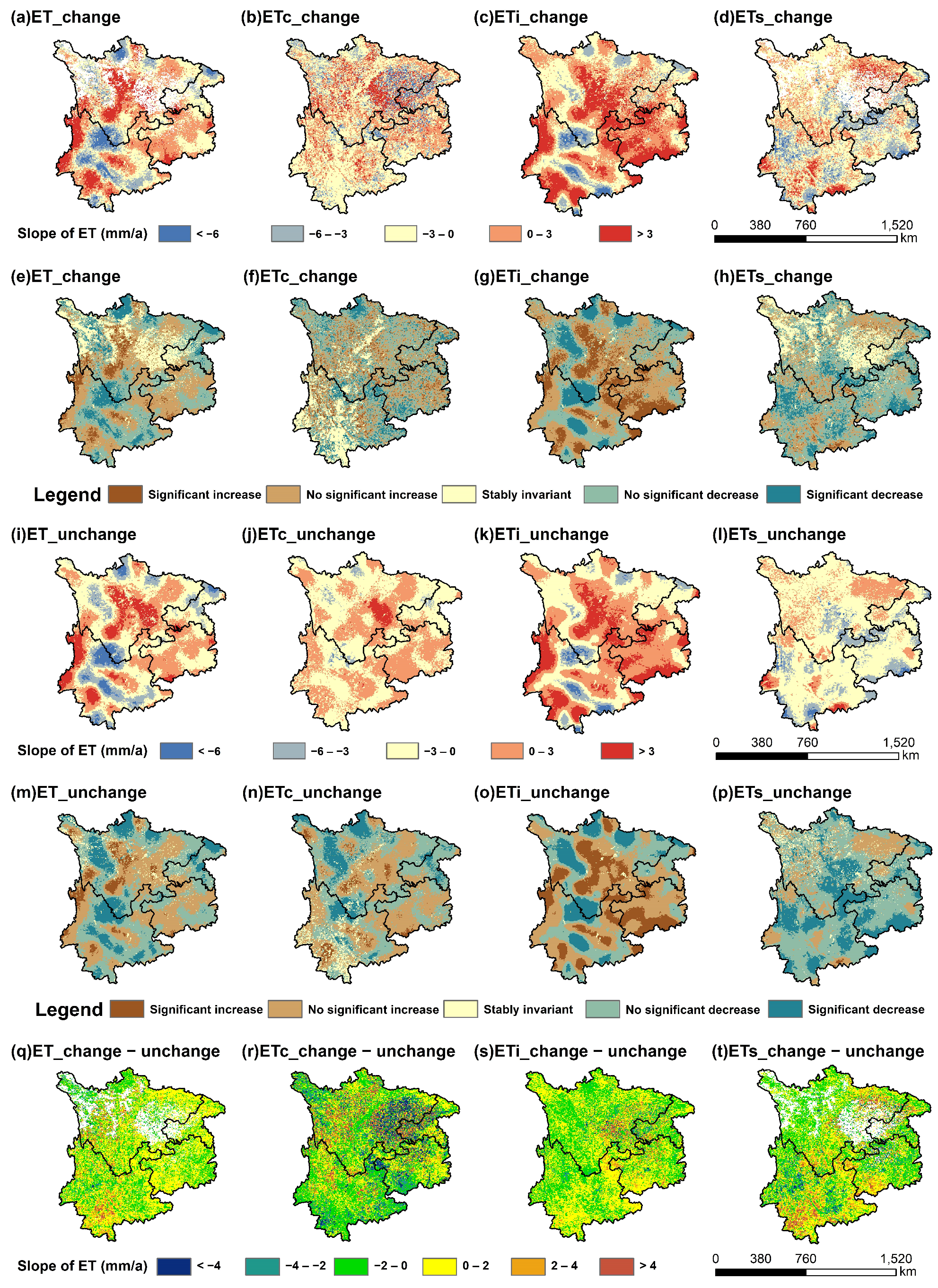
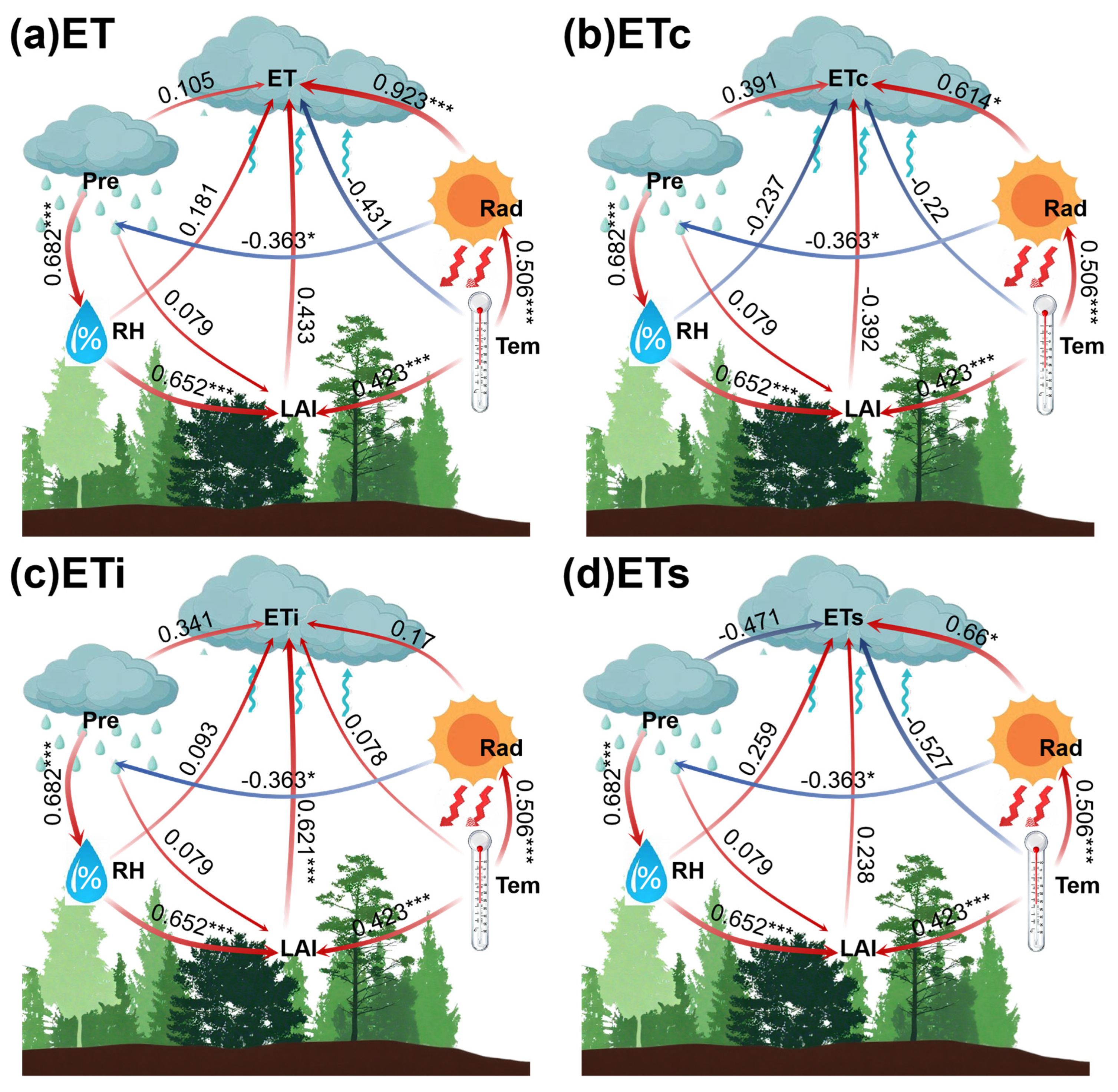
Disclaimer/Publisher’s Note: The statements, opinions and data contained in all publications are solely those of the individual author(s) and contributor(s) and not of MDPI and/or the editor(s). MDPI and/or the editor(s) disclaim responsibility for any injury to people or property resulting from any ideas, methods, instructions or products referred to in the content. |
© 2025 by the authors. Licensee MDPI, Basel, Switzerland. This article is an open access article distributed under the terms and conditions of the Creative Commons Attribution (CC BY) license (https://creativecommons.org/licenses/by/4.0/).
Share and Cite
Zhang, G.; Shen, Q.; Wang, Z.; Li, H.; Wang, Z.; Xue, T.; Wang, D.; Shi, H.; Liu, Y.; Wen, Z. Synergistic Regulation of Vegetation Greening and Climate Change on the Changes in Evapotranspiration and Its Components in the Karst Area of China. Agronomy 2025, 15, 2375. https://doi.org/10.3390/agronomy15102375
Zhang G, Shen Q, Wang Z, Li H, Wang Z, Xue T, Wang D, Shi H, Liu Y, Wen Z. Synergistic Regulation of Vegetation Greening and Climate Change on the Changes in Evapotranspiration and Its Components in the Karst Area of China. Agronomy. 2025; 15(10):2375. https://doi.org/10.3390/agronomy15102375
Chicago/Turabian StyleZhang, Geyu, Qiaotian Shen, Zijun Wang, Hao Li, Zongsen Wang, Tingyi Xue, Dangjun Wang, Haijing Shi, Yangyang Liu, and Zhongming Wen. 2025. "Synergistic Regulation of Vegetation Greening and Climate Change on the Changes in Evapotranspiration and Its Components in the Karst Area of China" Agronomy 15, no. 10: 2375. https://doi.org/10.3390/agronomy15102375
APA StyleZhang, G., Shen, Q., Wang, Z., Li, H., Wang, Z., Xue, T., Wang, D., Shi, H., Liu, Y., & Wen, Z. (2025). Synergistic Regulation of Vegetation Greening and Climate Change on the Changes in Evapotranspiration and Its Components in the Karst Area of China. Agronomy, 15(10), 2375. https://doi.org/10.3390/agronomy15102375






